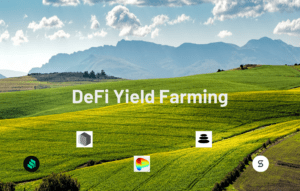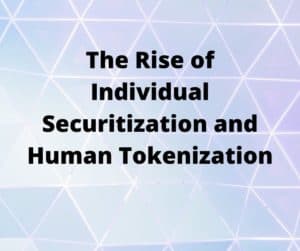The structure of this guide is meant to provide an overview of decentralized finance for beginners. First, I’ll provide an explanation of the DeFi and the properties that enable an open financial system. Next, I’ll jump into the concepts and terms of decentralized finance.
Feel free to jump to the sections you’re most interested in. However, we recommend reading through the whole guide to have a complete understanding of how decentralized finance protocols and applications operate together.
Note: this is not exhaustive, but serves as a strong introduction with concrete examples to Ethereum’s DeFi ecosystem.
Table of contents
- What is Decentralized Finance(DeFi) / Open Finance?
- How Decentralized Finance works?
- Is DeFi Useful and How will it Impact the World Economy?
- How Much Money is Locked in DeFi?
- What are Stablecoins?
- What are Crypto Lending and Borrowing Protocols?
- How Can I Obtain a Crypto-backed Loan or Earn Interest on my Cryptocurrency?
- What are the best crypto lending/interest-paying companies and protocols?
- What is a DEX (Decentralized Exchange)?
- What are Prediction Markets?
- What are the Prediction Markets on Ethereum?
- How do Prediction Markets Work?
- What is a no-loss lottery?
- What are Synthetic Assets?
- DeFi for Payments
- What Companies Accept Bitcoin and Ether for Payments?
- What is Decentralized Banking?
- What are Oracles?
- How Can You Participate in DeFi?
- Other Frequently Asked Questions
What is Decentralized Finance(DeFi) / Open Finance?
Decentralize Finance — or Open Finance — refers to the paradigm shift from today’s closed financial system towards an open financial economy based on open protocols that are interoperable, programmable, and composable.
Ethereum is creating a new economy that integrates blockchain technology and cryptocurrency with current financial systems.
DeFi is not about creating a new system from scratch. It is about democratizing the existing system and making it more equitable using open protocols and transparent data.
How Decentralized Finance works?
Decentralized Finance leverages three key principles of the Ethereum blockchain in order to revolutionize the existing financial system to empower individuals and provide greater financial freedom.
1. Interoperable
The current financial system is comprised of walled gardens (e.g. financial institutions) with limited transferability or two-way access.
Where interoperability is possible, it’s controlled by middlemen and rent-seekers. Open finance is defined by platforms that can work together with a degree of transparency and complement each other.
2. Programmable
Bitcoin revolutionized money by creating an asset that was self-sovereign and unbegotten by political influence. Ethereum has enabled new types of financial instruments and assets that are more customizable than existing products and services. Digital assets and securities will usher in a new era of financial mechanisms and growth.
Also Read: A Candid Explanation of Bitcoin
3. Composable
Composability refers to the concept that something can be selected and assembled in multiple combinations (e.g. Legos).
Ethereum has demonstrated the value of composability. It became a protocol for other protocols such as Maker, UMA, Augur, Compound, and many more.
Is DeFi Useful and How will it Impact the World Economy?
Decentralized Finance provides anyone in the world access to traditional financial services. Using blockchain technology, DeFi eliminates intermediaries and barriers to entry.
Admittedly, DeFi applications and services have the potential to provide greater benefits to citizens in developing nations and less stable economies.
However, the benefits of DeFi can still be realized by those in developed nations, especially when it comes to obtaining loans, investing in new assets, and new models of income generation.
You might also be interested in:
How Much Money is Locked in DeFi?
A common metric used in DeFi is the amount of money that is “locked” or in protocols.
Similar to banks and large companies use capital to create trillions in the value of financial products and derivatives. Ethereum protocols use capital to create value for DeFi products and applications.
Capital (Ether, dollars, other assets) that is stored in these protocols is referenced as the amount “locked in DeFi”. While the amount locked in dollar figures is relatively meaningless. However, the amount locked in terms of Ether or other cryptoassets can signify the growth of a defi protocol.
What are Stablecoins?
Stablecoins are cryptoassets that maintain a stable value against a target price (e.g., the U.S dollar).
There are multiple categories of stablecoins that have emerged over the course of the past two years.
Types of Stablecoins
Here are some of the types of stablecoins:
- Fiat-collateralized — backed by an individual currency or basket of currencies
- Crypto-collateralized — backed by cryptoassets, most commonly ether
- Resource backed — a stablecoin that is backed by another asset, such as gold
- Hybrid models — models that combine any of the above or add other attributes in order to maintain stability
Most stablecoins in development are focusing on a fiat-collateralized model. This model is easier to stabilize and integrate into the existing financial system.
Banks and financial institutions can more easily use a stablecoin denominated in a single currency or basket of currencies. As opposed to a stablecoin backed by cryptocurrencies such as bitcoin or ether.
Many companies are attempting to create stablecoins that can be used around the world.
Facebook is gearing up for Libra. Walmart is prepping for the Walmart Coin. Coinbase issued USDC, which is available in over 80 countries. Binance recently announced its stablecoin initiative, Venus.
JP Morgan created a digital asset for settling transactions between institutional clients. Institutions around the globe recognize the potential impact of stablecoins, evident from the International Monetary Fund stating
“Stablecoins are a threat to banking and cash.”
Crypto-collateralized stablecoins, such as the Dai stablecoin have already achieved relative success over the past few years. Dai was designed for maximal decentralization so that it wasn’t controlled by any single or group of entities.
The MakerDAO foundation, responsible for designing and developing the protocol that operates the Dai stablecoin. In addition, MakerDao utilizes a separate token called Maker (MKR) which helps Dai maintain its price peg.
What are Crypto Lending and Borrowing Protocols?
DeFi enables users to obtain a loan without a trusted party or middleman, such as a bank.
MakerDAO is one of the first applications that enables users from anywhere to obtain a loan. Maker Vaults require a deposit of ether and then lend Dai to the user.
However, one caveat with this is that users are required to keep a collateralization ratio of at least 150% . So if you placed 1 ETH in a Maker Vault at the price of $162/ETH, the CDP will automatically liquidate if ETH drops below $89.
While this type of loan requires depositing more capital upfront, it allows individuals to keep their underlying assets (ether). So imagine a situation in which you could deposit some type of asset that you were planning on holding for a while, such as S&P 500 indexes or potentially part of your 401k.
With this type of lending structure, you would be able to get a loan off of your capital without having to sell it. However, this isn’t particularly useful for borrowing large amounts of money, it has the potential to help individuals borrow smaller amounts.
More recently, more types of lending and borrowing protocols have been built on top of Ethereum. These protocols include Compound, Fulcrum, Aave, and more. Compound and Fulcrum both create pools of capital allowing users to lend or borrow cryptoassets including Dai, USDC (Coinbase’s stablecoin), ether, and more.
Checkout DeFi Lending and Borrow Applications
Crypto lending and borrowing protocols essentially break the barrier to access capital. Obtaining a loan in the traditional financial system requires going to a bank and meeting the necessary requirements (credit score, job, etc).
Often times, the requirements can hurt the very people who need loans the most, such as people who are self-employed, students, local entrepreneurs, or members of disenfranchised communities.
Access to capital is a fundamental prerequisite for being able to obtain financial freedom which is often guarded and controlled by legacy institutions.
How Can I Obtain a Crypto-backed Loan or Earn Interest on my Cryptocurrency?
Anyone can utilize the Compound protocol by downloading MetaMask or another crypto wallet.
Dharma — a company that originally competed with Compound — now leverages Compound’s protocol to provide its customers with the best interest rate possible. Dharma achieves this through its “smart wallet” which automatically deposits customers’ funds into the Compound protocol.
Also Read: Best Smart Contract Wallets (DeFi Wallets)
More recently, many cryptocurrency exchanges, such as Binance have also started to offer borrowing and lending services for various cryptoassets.
While using a cryptocurrency exchange would be classified as a more centralized option than Compound, it is arguably less centralized than a traditional bank because Binance and other exchanges are utilizing decentralized stablecoins and cryptoassets that are not controlled by a single country (e.g. U.S dollar).
These various protocols showcase the power of compatibility:
1) Dharma provides an open platform by
2) leveraging Compound’s open protocol,
3) which predominantly lends and borrows the Dai stablecoin created by MakerDAO’s protocol
4) all on top of Ethereum. Welcome to the new financial system.
What are the best crypto lending/interest-paying companies and protocols?
However, there’s more to DeFi lending and borrowing than chasing the best interest rates. There are a multitude of factors that you should consider before using a lending protocol including the risk from smart contracts and the amount of pooled liquidity.
To help individuals in the community and new users, ConsenSys created the DeFi Score, a single, consistently comparable value for measuring platform risk, based on factors including smart contract risk, collateralization, and liquidity.
The DeFi Score is a framework for quantifying risk in permissionless lending pools. Originally conceived of by a team at ConsenSys, the project is now open source and open for community contribution.
You should evaluate all of these factors before deciding on the protocol/company that you decided to lend with.
What is a DEX (Decentralized Exchange)?
Financial systems operate through open markets and require robust mechanisms for trading and transferring value. So far the cryptoasset trading landscape is primarily dominated by a few large players, predominantly Coinbase, Kraken, Gemini, Bitstamp, Bitfinex, and Binance. All of these exchanges are centralized and therefore controlled by a group of individuals or companies.
Decentralized exchanges offer a new model to trade and exchange assets which don’t require the reliance on a single intermediary or oligopoly (controlled by a few individuals/firms).
Uniswap emerged this year as the go-to decentralized exchange (DEX) for trading cryptocurrencies in a disintermediated fashion. Uniswap reported trading volume of over $8 million in a twenty-four period in November of 2019.
Uniswap currently comprises 33% of all DEX volume which exceeds IDEX and Kyber. Another decentralized exchange dYdX developed a platform combining trading, borrowing, and lending. The dYdX decentralized exchange aggregates spot prices and lending liquidity across multiple exchanges for its users. Other decentralized exchanges or protocols include 0x, AirSwap, Bancor, Kyber, IDEX, Paradex and Radar Relay.
Blockchain analytics firm Alethio created DEXWatch in order to monitor decentralized exchange activity including tokens, traders, and trades. DEXWatch shows graphs and charts of decentralized exchange activity.
Also Read: Best Blockchain Analytics Softwares
What are Prediction Markets?
Prediction markets are platforms that enable individuals to bet or gamble on the outcome of events, games, elections, etc. Predictit is one of the most known prediction market apps, although users from various countries are not allowed to create accounts and use the application.
Many jurisdictions throughout the world do not allow individuals to gamble or bet on specific events including elections, sports, judicial outcomes, and other controversial events.
Ethereum enables prediction markets that can operate outside jurisdictional limitations providing a true prediction market that everyone around the world can access. Why is this important? Prediction markets platforms and applications rely on the “wisdom of the crowd” to decide the probability of any outcome. The concept, based on proven scientific evidence states that a large number of people (the crowd) will almost always be more accurate than individual experts when it comes to predicting the outcome of general events.
What are the Prediction Markets on Ethereum?
Augur is a prediction market platform in which any individual can create or bet on a market (game, event, election). The Augur protocol, which runs on top of the Ethereum blockchain, allows individuals to buy or sell shares of a potential outcome.
Numerai’s stock prediction tournament where data scientists create models for trading on the stock market requires that data scientists bet on their own predictions with personal capital in the form of NMR tokens. The data scientists are then rewarded on the accuracy of their predictions and based on the amount of capital that they placed. The more conviction, the more an individual is willing to bet or stake on their trading model.
Additionally, Numerai has created the Erasure protocol which provides a data marketplace where individuals can use their specific knowledge to sell predictions or information about the world that are transparent and contractually enforceable. The Numerai tournament and Erasure marketplace provide opportunities for any individual to earn an income based on their skills or unique personal knowledge.
How do Prediction Markets Work?
For instance, a market creator can generate the market for: “Which team will win the Champions League?”
The creator of the market can define a set of possible outcomes, like “Juventus” or “Real Madrid” At the start, these options are split into shares, with all shares summing to $1.00, or a 100% probability. Possessing a winning share earns $1.00. For instance, if there’s a 51 percent chance that Real Madrid will win — and they do — each Real Madrid shareowner will receive $1.00 per share.
What is a no-loss lottery?
A no-loss lottery refers to a standard lottery in which participants do not lose their initial investment. No-loss lotteries pool all the money from purchased tickets and invest the money into some type of asset. The returns of the asset over a pre-determined period of time are then distributed to whoever wins the lottery.
PoolTogether, a no-loss lottery built on Ethereum, enables individuals to purchase lottery tickets using Dai. PoolTogether allows anyone to purchase a lottery ticket in Dai and then the proceeds are held in Compound (generating interest) for a certain period of time (week, month, year). The winner of the lottery receives the combined interest that has accrued from all the pooled funds and everyone else (the losers) receives their original money back.
While no-loss lotteries limit the upside of the amount that any individual can potentially win, this type of lottery prevents the chronic loss that many individuals suffer from when gambling on lottery tickets.
What are Synthetic Assets?
Synthetic assets aren’t unique to decentralized finance. Most people now have a familiarity with why the Financial Housing Crisis of 2008 occurred: The large banks took a bunch of mortgage-backed securities (bonds, financial products, etc), and then created new derivatives and synthetic securities that were primarily used to speculate on mortgages and the housing market. When the housing market collapsed, the value of all mortgage-backed securities collapsed along with most of the synthetic assets that were somehow derived from those other securities.
However, this isn’t to say that tools and financial mechanisms for speculation are inherently bad. Tools and mechanisms for speculation are a vital component for any new asset class, especially an asset aiming to be the bedrock of an open financial system. The financial crisis of 2008 was, in part, more drastic because much of the information — from how bonds were rated to how assets were price — was controlled by centralized entities that were not transparent. One critical aspect of Ethereum is that these protocols are open and accessible by anyone.
Currently, companies are creating protocols that will enable the creation of synthetic assets and derivatives encoded by smart contracts. UMA (Universal Market Access) is creating a derivatives platform providing standardized contracts for financial products. Another crypto company, Synthetix is developing a protocol that enables the creation and issuance of synthetic assets such as cryptocurrencies, fiat currencies, and commodities.
Synthetic assets and derivatives provided by open source protocols will generate value for investors who seek to hedge against risk, diversify capital allocation, and find mechanisms to increase the return on investments. There are no limits to the types of derivatives that can be created using cryptoassets.
For instance, there are already over a dozen variations of Dai in existence that have been created by other DeFi protocols. Ethereum’s data transparency, combined with the potential to build on top of and operate with other Ethereum based protocols provides limitless possibilities for what can be created in the decentralized finance ecosystem.
DeFi for Payments
As the world naturally switches to digitally native payments, mechanisms to pay with crypto — which may eventually become the internet’s native currency — will be more utilized in day-to-day transactions.
Ethereum naturally allows anyone to make cross-border payments or transact without paying the intermediary fees common among traditional financial services.
Ethereum also enables micropayments and allows individuals to make remittance payments with ease. Global payments and remittances today are executed by a number of intermediaries that exact tolls for their service. It takes 2 to 7 days and costs a global average of 6.94% to send $200 between countries. DeFi can streamline payment and remittance processes, reducing settlement times, and significantly reducing costs for users around the globe.
What Companies Accept Bitcoin and Ether for Payments?
More companies are accepting bitcoin, ether, or dai as a payment method as the crypto ecosystem expands. Lolli enables users to earn bitcoin as they shop online.
While you cannot pay on Amazon with ether or dai, more companies will provide the optionality in the coming years.
Also Read: Best Bitcoin Payment Processors
What is Decentralized Banking?
Decentralized banking refers to the concept of obfuscating the need for a bank account. 70% of Filipinos remain unbanked and have no access to a checking or savings account. This is not uncommon as billions of individuals around the world don’t have access to the same financial system as those in more developed economies.
Banking the unbanked will required a combination of IoT and blockchain technology in order to provide everyone access to financial services.
DeFi is building out many of the applications and services of decentralized banking, including borrowing and lending, payments, and investing. Other important features including identity, crypto wallets, insurance, data storage, and many more are all being developed by individuals or companies within the broader Ethereum ecosystem.
What are Oracles?
An oracle is any system that provides external data for on-chain use. Without an oracle, a smart contract on Ethereum will only be able to perform operations with on-chain data. Oracles expand the potential use cases for smart contracts including insurance, finance, and more robust prediction markets.
Decentralized oracle provider, Rhombus divides oracles into two broad buckets:
- how the oracle is activated
- how the oracle replies
The Rhombus API for running oracles has predictable, resource-oriented functions that enable you to connect a smart contract with real-world data. The ability to access accurate and trustworthy data is of the utmost importance when large sums of money are being distributed as is the case with decentralized financial applications. For more about oracles visit Ethereum.org.
How Can You Participate in DeFi?
To participate or grow Ethereum adoption, you can start by purchasing Dai and using it where you can/live.
If you’re a developer, contribute to open source projects and tools working on bringing Dai and stablecoins to the world.
If you’re an enthusiast, educate who you can, write, or translate articles into different languages. What makes crypto unique is the open-source global community and everyone is welcome.
Other Frequently Asked Questions
How important will blockchain be to the world’s economy?
Blockchain networks, specifically Ethereum will fundamentally change how the world’s economy operates by reducing operating costs, eliminating middlemen, and creating new markets.
Obviously, it’s impossible to predict how the future will look a decade from now, however, blockchain technology will become an integral component of business functions and everyday life.
Read more about how blockchain technology will impact various global industries including supply chain management, energy, government, real estate, and more.
Can you profit from investing in a stablecoins like Dai or USDC?
Stablecoins are designed to reduce the instability of cryptocurrencies (i.e bitcoin, ether) by holding a constant value.
Therefore, purchasing Dai or USDC and holding them in your wallet will not result in an increase in value.
However, various crypto lending protocols such as Compound and Fulcrum offer interest for lending stablecoins such as Dai or USDC.
So while you cannot profit from stablecoins increasing in price value, it is possible to benefit indirectly by lending stablecoins that you are not using — similar to how your bank provides an interest rate for keeping your cash in the bank.
The difference is that banks provide very poor interest rates while lending protocols can generate returns around 4–9% depending on the protocol. There is added risk in using any crypto lending protocols which you can learn more about on Defi Score.
Do cryptocurrencies pay dividends?
Most cryptocurrencies do not pay dividends in the traditional sense of the word. Ether, Ethereum’s native cryptocurrency does not pay dividends nor does bitcoin.
However, security tokens and other financial cryptoassets may pay dividends or entitle the owner to a share of company revenue depending on the design.
Is there a better DeFi blockchain than Ethereum?
No. Ethereum has established a dominant hold on decentralized financial applications partly because Ethereum has 4x as many developers as the next blockchain network.
While other blockchain networks have gained usage for gambling applications, the more centralized nature of other blockchains has resulted in less financial based applications.
Ethereum’s decentralized nature ensures that individuals trust the protocols and applications developing on top of it.
What are the blockchain applications in financial services?
The Ethereum blockchain enables more open, inclusive, and secure business networks, shared operating models, more efficient processes, reduced costs, and new products and services in banking and finance.
It enables digital securities to be issued within shorter periods of time, at lower unit costs, with greater levels of customization. Digital financial instruments can be tailored to investor demands, expanding the market for investors, decreasing costs for issuers, and reducing counterparty risk.

Advancing Web 3.0 is a weekly newsletter about cryptocurrencies, decentralized finance (DeFi), and technologies that are shaping the next era of the Internet. Welcome to the bleeding edge. Welcome to Web 3.
Don’t get left behind — subscribe.
About the Author: I’m Mason Nystrom, a writer, and aspiring angel investor. Previously I worked for ConsenSys as a marketer focused on marketing strategy for ConsenSys and its portfolio companies. Prior to joining ConsenSys, I worked as a Business Analyst at Gatecoin, the first cryptocurrency exchange to list ether, Ethereum’s native cryptocurrency.
I’m passionate about Bitcoin, Ethereum, DeFi, Web 3.0, and all things crypto. When I’m not writing or heads down in crypto, I’m learning to become a developer.
The views, information, and opinions expressed are solely those by the author and are meant for informational purposes. It is not intended to serve as a recommendation or investment advice to buy or sell any securities, cryptoassets, or other financial products.











